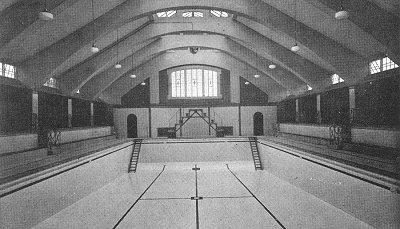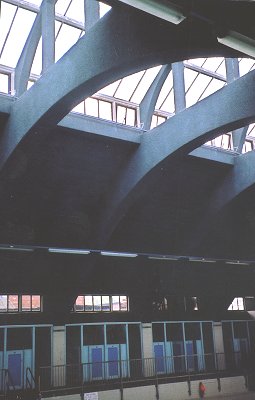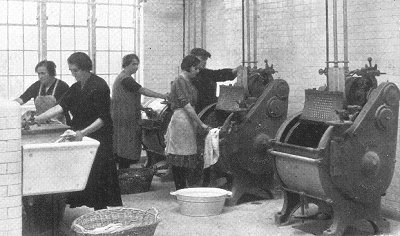|
HEATH TOWN BATHS AND LIBRARY
page 4
| Such "municipal modernism" constitutes the Heath Town building's
immediate claim to local architectural fame. Its claim on national
recognition lies elsewhere: it may have a significant place in the
developing use of the elliptical concrete arch in swimming bath
construction. This appeared about the end of the First War, and early
instances are considered unexciting (Saint 1991, 8); for example Croydon
baths, of 1926, despite the prominent concrete ribs, has conventional
ceiling panels, and limited top and side lighting. A new impetus to concrete
design was given by the striking Royal Horticultural Hall of 1927-8, with
its stepped tiers and multiple clerestories; this aroused much interest, and
one result was "a little rash of elliptically arched British municipal pools
in the early 1930s" (Saint 1991, 10). Generally held to be the first was
Poplar baths, commissioned from the Borough Engineer in 1929, but delayed by
the national economic crisis, and not completed till 1934 (Saint 1991, 10) -
that is some two years after Heath Town. The arch and clerestory design is
strikingly reminiscent of the Royal Horticultural Hall, and more elaborate
than Heath Town's. |
|

The interior of the main bath,
from the Book of the Century. |
Nevertheless the bold, tiered arches of Heath Town, allowing one
clerestory combined with prominent top lighting, and continuous side
lighting mark a perceptible advance on the Croydon
design, and certainly echo the Horticultural Hall. |
| These arches perhaps entitle H B Robinson and Wallace Wood
to be regarded as national pioneers in this particular field of municipal
building. That would be no more than Robinson deserved, for one constant
thread in the story of the Heath Town baths project was his determination to
keep abreast of all the latest developments. As he wrote in his key 1930
report to the Council which launched the work: "the Borough Surveyor, at
your Committee's request, visited several recently constructed Public Baths
in London and the provinces, so that there might be incorporated in the new
buildings all suitable recent improvements in design" (Wolverhampton Borough
Council 1930, 655). It has been argued that Heath Town's two-in-one Public Baths and Library
has a significant place in the social and political history of
Wolverhampton, and in both local and national architectural history, between
the World Wars. That place seems worthy of public recognition. Given
subsequent changes to Heath Town and Borough service provision, and the
reported structural problem in the main swimming bath, the question is:
recognition of what kind? |

Showing the clerestory combined with
prominent top lighting, and continuous side lighting. |
| |
|
 |
Read about the Heath Town
Swimming Club |
| |
|
| Sources Manuscript / Typescript : in Wolverhampton Archives
CMB/WOL/C/PB/25: Minutes of the Parks and Baths Committee, 1931-33
CMB/WOL/D/LIB/128.6: File on Branch Libraries 1926-47
Printed
Best G (1979): Mid-Victorian Britain 1851-1875,Fontana
Brew A (1999): Heath Town and Fallings Park, Tempus
Mason F (1982): Yesterday's Town: Wolverhampton, Barracuda
Saint A (1991): "Some Thoughts about the Architectural Use of Concrete",
Architectural Association Files no. 22 (Kindly supplied by Elain Harwood)
Wolverhampton Borough Council (1926, 1929, 1930): Minutes and Reports of
Wolverhampton Borough Council
Wolverhampton Borough Council (1948); The Book of the Century
Additional note:
The Book of the Century, page 135 – 136, contained the following account
of the building and picture of part of the wash house:
|
 |
"A branch establishment in Tudor Road, Heath Town was opened on Friday,
16th
December 1932, and the cost of the buildings, exclusive of boilers,
purification plant and hot water work was £33,764. This establishment includes a Main Swimming Bath, 75 feet by 34 feet
containing 85,000 gallons of water, and a special Children’s Swimming Bath
40 feet by 25 feet with water depths ranging from three feet three inches to
three feet and contains 20,000 gallons of water. |
| On the South side of the building is a Public Wash-house, comprising
fifteen washing stalls for hand washing, four rotary washing machines, three
electrically operated hydro-extractors, and twenty one drying horses. All water is softened to effect the greatest economy in the use of soap."
|
 |
|
 |
|
 |
Return to
Listed Buildings |
|
Return to
Interesting Buildings |
|
Return to Sports
and Leisure |
|